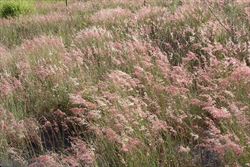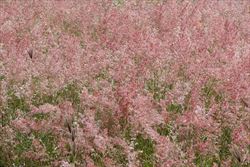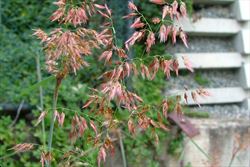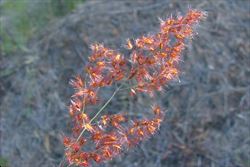Click on images to enlarge

infestation (Photo: Chris Gardiner)

infestation (Photo: Forest and Kim Starr, USGS)

habit with young seed-heads (Photo: Sheldon Navie)

habit with mature seed-heads (Photo: Sheldon Navie)

leaves (Photo: Sheldon Navie)

close-up of young seed-head (Photo: Sheldon Navie)

seed-head in flower (Photo: Sheldon Navie)

mature seed-head (Photo: Sheldon Navie)

close-up of seeds (Photo: Sheldon Navie)

young plant (Photo: Sheldon Navie)
Scientific Name
Melinis repens (Willd.) Zizka
Synonyms
Melinis repens (Willd.) Zizka subsp. repensRhynchelytrum repens (Willd.) C.E. Hubb.Saccharum repens Willd.
Family
Gramineae (South Australia)Poaceae (Queensland, New South Wales, the ACT, Victoria, Tasmania, Western Australia and the Northern Territory)
Common Names
blanketgrass, Holme's grass, Natal grass, Natal red top, Natal redtop, Natalgrass, red Natal grass, rose Natal grass, ruby grass
Origin
Native to the Canary Islands, Africa (i.e. Morocco, Chad, Ethiopia, Somalia, Sudan, Kenya, Tanzania, Uganda, Burundi, Cameroon, the Central African Republic, Rwanda, Zaire, Benin, Burkina Faso, Ivory Coast, Ghana, Niger, Nigeria, Sierra Leone, Togo, Angola, Malawi, Mozambique, Zambia, Zimbabwe, Botswana, Lesotho, Namibia, South Africa and Swaziland), the Seychelles, the Arabian Peninsula (i.e. Oman, Saudi Arabia and Yemen) and India.
Naturalised Distribution
Very widely naturalised in Australia, and most abundant in the northern and eastern parts of the country. It is common in Queensland, the Northern Territory and eastern New South Wales and scattered in other parts of New South Wales, in southern Victoria, in northern and south-western Western Australia and some parts of South Australia. Also naturalised on Norfolk Island and Christmas Island.
Widely naturalised elsewhere in the world, including southern USA (i.e. California, Arizona, New Mexico, Texas, Louisiana, Florida, Georgia and North Carolina) and on several Pacific islands (i.e. the Cook Islands, Fiji, French Polynesia, Guam, Kiribati, Nauru, New Caledonia, the Solomon Islands and Hawaii.
Habitat
A very common weed of roadsides, railways, parks, gardens, footpaths, disturbed sites, waste areas, pastures and crops in tropical and sub-tropical regions. Also present in temperate, semi-arid and arid areas.
Habit
A short or long-lived (i.e. annual or perennial) grass forming open tussocks and growing up to 1.2 m tall.
Distinguishing Features
- a short-lived or long-lived grass forming open tussocks with upright flowering stems up to 1 m tall.
- its open seed-heads are usually a distinctive reddish colour when young.
- these seed-heads turn pink and then whitish in colour as they mature.
- its numerous flower spikelets are covered in silky hairs that give the seed-heads a fluffy appearance.
Stems and Leaves
The flowering stems (i.e. culms) are hairless (i.e. glabrous) and occasionally branched.
The leaves consist of a leaf sheath, which partially encloses the stem, and a spreading leaf blade. Both the sheath and the blade of the leaf can be either hairless or hairy (i.e. glabrous or pubescent). The leaf blades (5-30 cm long and 0.2-1 cm wide) are long and narrow (i.e. linear) and may be either folded or flat. There is a small membranous structure (i.e. ligule) at the junction of the leaf sheath and leaf blade which is topped with hairs about 2 mm long (i.e. it is ciliate).
Flowers and Fruit
The seed-head (i.e. inflorescence) is a branched panicle (5-20 cm long), with many conspicuously hairy flower spikelets. These flower spikelets (2-12 mm long) are densely covered with silky hairs (2-6 mm long) that are initially reddish or purplish in colour. These hairs tend to lose their colour as the seed-heads mature and often end up a pinkish or silvery colour. Flowering occurs throughout the year.
The 'seed' (i.e. caryopsis or grain) is egg-shaped in outline (i.e. ovate), flattened, and light brown in colour (about 1.3 mm long).
Reproduction and Dispersal
Red Natal grass (Melinis repens) reproduces mainly by seed. These light and fluffy seeds are often wind-dispersed and may also become lodged in clothing, vehicles and animals. Seeds can also be spread in mud and contaminated agricultural produce (i.e. fodder and pasture seed).
Environmental Impact
Red Natal grass (Melinis repens ) is regarded as an environmental weed in Queensland, New South Wales, Western Australia and the Northern Territory. It was also recently listed as a priority environmental weed in at least one Natural Resource Management region.
Legislation
Not declared or considered noxious by any state government authorities.
Similar Species
Red Natal grass (Melinis repens) is similar to molasses grass (Melinis minutiflora). These two species can be distinguished by the following differences:
- red Natal grass (Melinis repens) is a tufted plant with upright (i.e. erect) or semi-upright (i.e. geniculately ascending) flowering stems. Its flower spikelets are relatively large (2-12 mm long) and densely covered in silky, reddish-coloured, hairs.
- molasses grass (Melinis minutiflora) is a mat-forming plant with creeping (i.e. stoloniferous) stems and semi-upright (i.e. geniculately ascending) flowering stems. Its flower spikelets are quite small (1.5-2.5 mm long) and mostly hairless, but usually bear a small hair-like awn (0-15 mm long).

